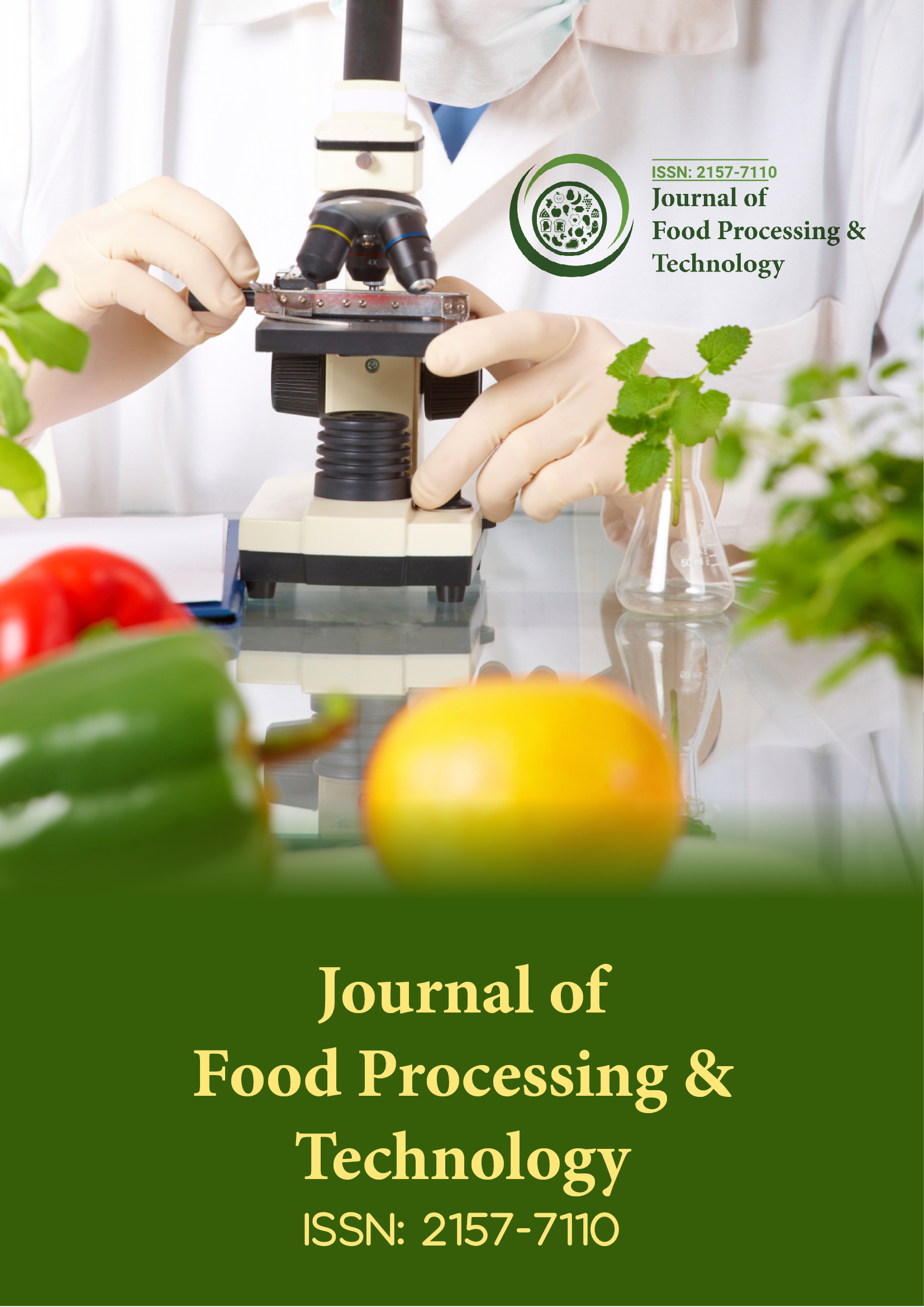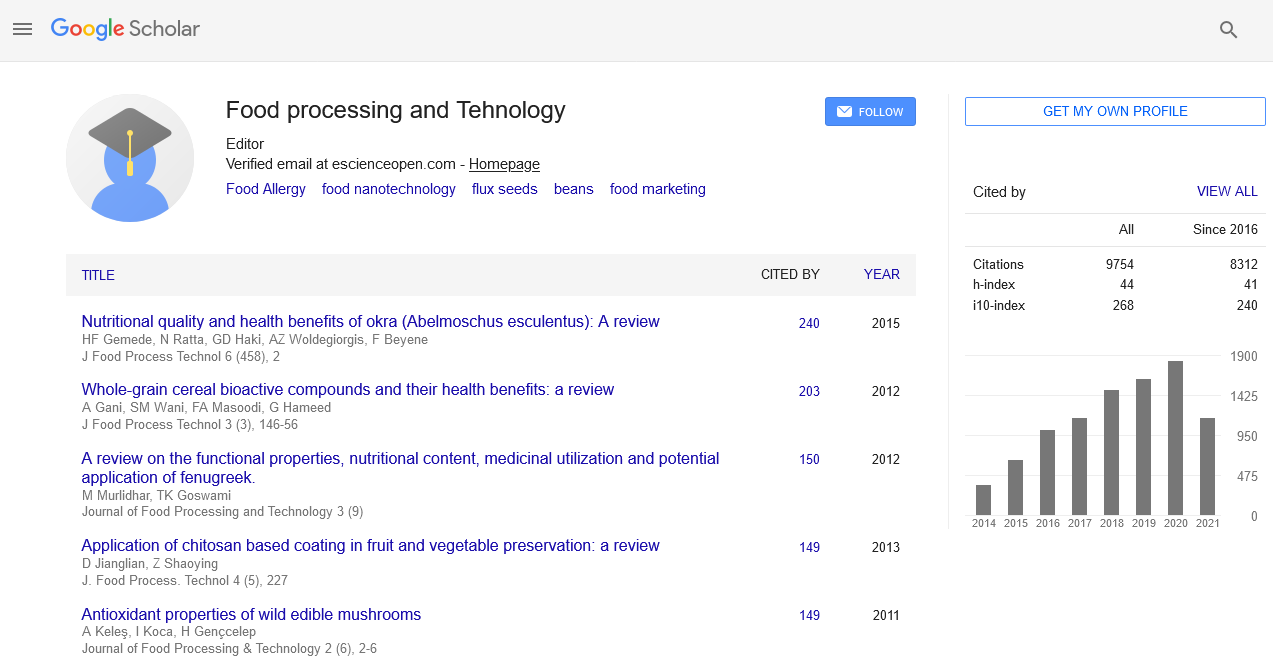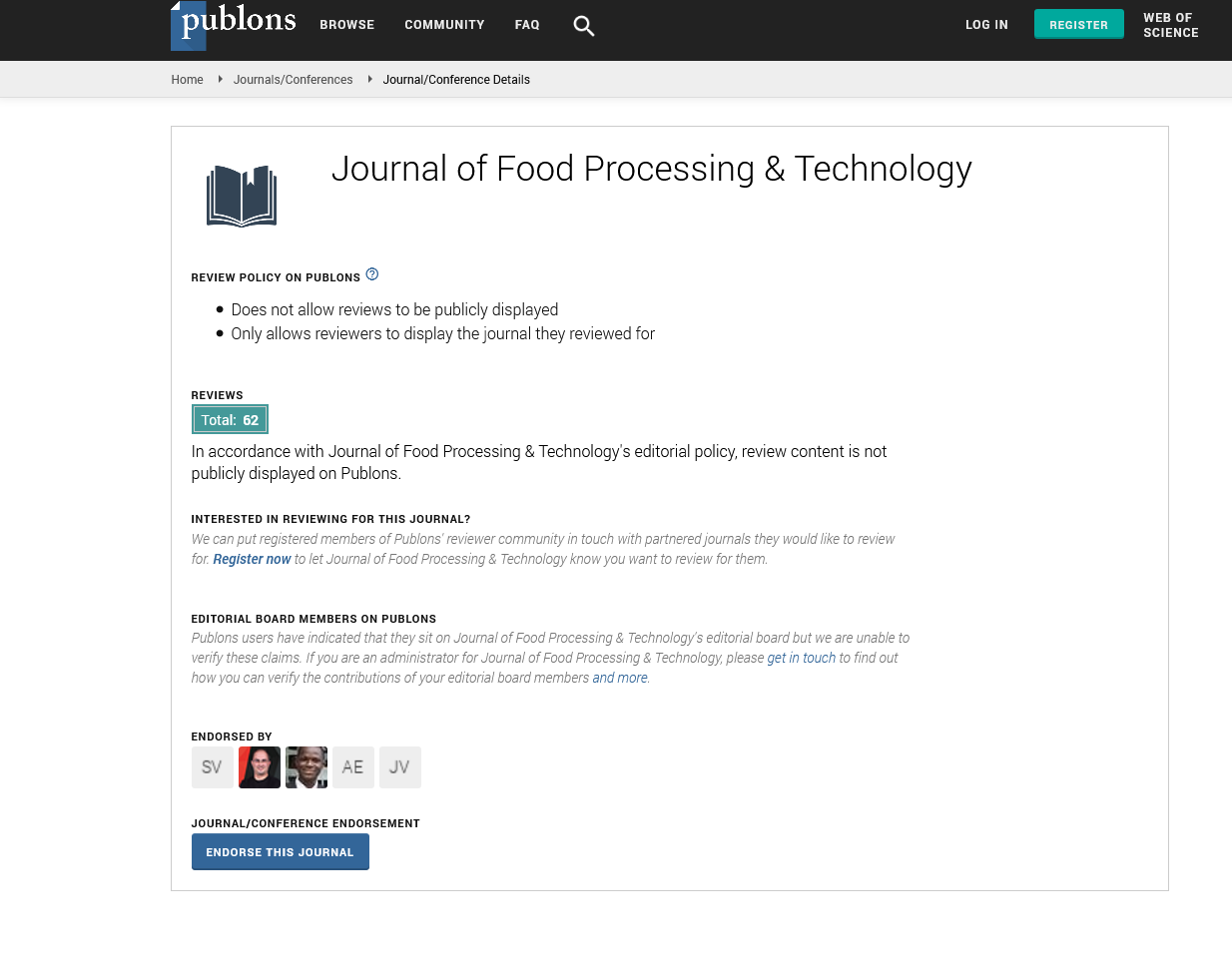Indexed In
- Genamics JournalSeek
- Academic Keys
- JournalTOCs
- China National Knowledge Infrastructure (CNKI)
- Access to Global Online Research in Agriculture (AGORA)
- Centre for Agriculture and Biosciences International (CABI)
- RefSeek
- Directory of Research Journal Indexing (DRJI)
- Hamdard University
- EBSCO A-Z
- OCLC- WorldCat
- Scholarsteer
- SWB online catalog
- Publons
- Euro Pub
- Google Scholar
Useful Links
Share This Page
Journal Flyer

Open Access Journals
- Agri and Aquaculture
- Biochemistry
- Bioinformatics & Systems Biology
- Business & Management
- Chemistry
- Clinical Sciences
- Engineering
- Food & Nutrition
- General Science
- Genetics & Molecular Biology
- Immunology & Microbiology
- Medical Sciences
- Neuroscience & Psychology
- Nursing & Health Care
- Pharmaceutical Sciences
Opinion Article - (2025) Volume 16, Issue 1
Valorization of Food Waste Through Fermentation Technologies
Olivia Green*Received: 27-Jan-2025, Manuscript No. JFPT-25-29179; Editor assigned: 29-Jan-2025, Pre QC No. JFPT-25-29179; Reviewed: 12-Feb-2025, QC No. JFPT-25-29179; Revised: 18-Feb-2025, Manuscript No. JFPT-25-29179; Published: 26-Feb-2025, DOI: 10.35248/2157-7110.25.16.1146
Description
The valorization of food waste through fermentation technologies represents a sustainable and innovative approach to address the global challenge of food waste management. As food production and consumption continue to rise, so does the generation of vast amounts of waste at various stages of the food supply chain, including agriculture, processing, retail and households. A significant portion of this waste, rich in organic matter and nutrients, ends up in landfills, contributing to greenhouse gas emissions, environmental pollution and economic losses. However, with the advancement of biotechnological tools and microbial processes, food waste can be transformed into valuable products through fermentation, creating a circular economy that reduces environmental impact while producing bio-based chemicals, fuels, enzymes and functional food ingredients.
Fermentation, a metabolic process carried out by microorganisms such as bacteria, yeasts and fungi, has long been used in food preservation and flavor development. More recently, its potential has expanded into waste valorization, leveraging microbial activity to convert complex organic waste into commercially useful substances. The biochemical diversity of microbes enables the breakdown of carbohydrates, proteins and lipids found in food waste into simpler molecules, which are then converted into a range of valuable metabolites. This process not only diverts waste from landfills but also offers a low-cost and energy-efficient alternative to traditional chemical synthesis methods.
One of the most promising applications of fermentation in food waste valorization is the production of organic acids such as lactic acid, acetic acid, citric acid and succinic acid. These acids serve as key building blocks in the food, pharmaceutical and polymer industries. For example, lactic acid produced from starchy or sugary food residues can be used to manufacture Poly Lactic Acid (PLA), a biodegradable plastic with numerous packaging applications. Similarly, citric acid, commonly produced from fruit peels and pulp waste, is extensively used as an acidulant and preservative in beverages and processed foods. By utilizing food waste as a substrate, the production costs of these acids are significantly reduced and the dependence on synthetic or fossil-based resources is minimized.
Another valuable product derived from the fermentation of food waste is bioethanol, a renewable biofuel that can be used as an alternative to gasoline. Fruit and vegetable waste, rich in fermentable sugars, serves as an excellent feedstock for ethanol production through yeast fermentation. The use of lignocellulosic food residues, such as corn husks or wheat bran, requires a pre-treatment step to break down complex polysaccharides into fermentable sugars, followed by microbial fermentation. This approach not only contributes to energy sustainability but also provides a means to manage agricultural waste efficiently.
In addition to bioethanol, other biofuels such as biobutanol and biogas (methane) can also be produced using mixed microbial consortia in anaerobic fermentation systems, further diversifying the energy potential of food waste.
Fermentation technologies also play a crucial role in the generation of Single-Cell Proteins (SCP), which are microbial biomass or protein extracts obtained from the cultivation of bacteria, yeasts, or fungi on food waste substrates. These proteins are increasingly considered as sustainable alternatives to traditional animal and plant protein sources in animal feed and, potentially, human nutrition. Food industry by-products such as whey, spent grain and fruit pulps are excellent raw materials for SCP production, supporting protein recycling and reducing the strain on conventional protein production systems.
Moreover, fermentation processes can be employed to extract bioactive compounds and functional ingredients from food waste. Antioxidants, peptides, enzymes and vitamins can be liberated or enhanced during microbial fermentation. For instance, the fermentation of citrus peel waste can lead to the release of flavonoids and polyphenols with antioxidant and anti-inflammatory properties. Similarly, protein-rich residues such as soybean meal or fish waste can be fermented to produce bioactive peptides with potential health benefits, including antihypertensive and antimicrobial effects. These compounds can be incorporated into functional foods, nutraceuticals, or cosmetic products, thus adding value to what was once considered waste.
In the field of agriculture, fermented food waste can be transformed into biofertilizers and soil conditioners. During the fermentation process, organic matter is decomposed and stabilized, resulting in nutrient-rich compost or liquid fertilizers that enhance soil health and crop productivity. The use of such bio-based fertilizers contributes to sustainable agriculture by reducing the reliance on synthetic fertilizers and closing nutrient loops within the food system. Additionally, certain fermentation processes promote the development of beneficial microbial communities, which can suppress plant pathogens and support plant growth.
Despite the numerous advantages of food waste valorization through fermentation, there are challenges that must be addressed to ensure widespread adoption and scalability. One key challenge is the heterogeneity of food waste, which varies in composition depending on the source, season and processing method. This variability can affect the efficiency and consistency of fermentation processes. Standardizing pre-treatment methods and developing robust microbial strains capable of adapting to different waste compositions are critical for optimizing yield and process stability.
Furthermore, economic feasibility and regulatory considerations play a vital role in the implementation of fermentation-based waste valorization at an industrial scale. Investment in infrastructure, transportation and waste segregation systems is necessary to support the continuous supply of quality substrates. Regulatory frameworks that ensure the safety of products derived from food waste, particularly for food and feed applications, must be clearly defined and enforced to gain consumer trust and compliance.
In conclusion, fermentation technologies offer a highly effective and environmentally friendly solution for the valorization of food waste. By converting discarded organic matter into valuable products such as biofuels, organic acids, proteins and functional compounds, fermentation not only addresses the issue of food waste but also contributes to the development of a bio-based circular economy. With advances in microbial biotechnology, process engineering and policy support, the future of food waste valorization through fermentation is promising and holds the potential to transform waste into wealth while promoting sustainability across the food and energy sectors.
Citation: Green O (2025). Valorization of Food Waste Through Fermentation Technologies. J Food Process Technol.16: 1146.
Copyright: © 2025 Green O. This is an open access article distributed under the terms of the Creative Commons Attribution License, which permits unrestricted use, distribution and reproduction in any medium, provided the original author and source are credited.


